

Christmas. Music Community Tribe of Noise Acquired Free Music Archive.
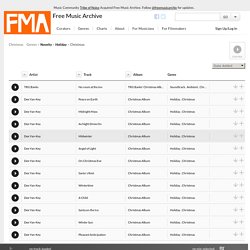
Follow @freemusicarchiv for updates. Search Music. Legal Encyclopedia, Legal Forms, Law Books, & Software. Measuring Fair Use: The Four Factors - Copyright Overview by Rich Stim. Unfortunately, the only way to get a definitive answer on whether a particular use is a fair use is to have it resolved in federal court. Judges use four factors to resolve fair use disputes, as discussed in detail below.
It’s important to understand that these factors are only guidelines that courts are free to adapt to particular situations on a case‑by‑case basis. In other words, a judge has a great deal of freedom when making a fair use determination, so the outcome in any given case can be hard to predict. The four factors judges consider are: the purpose and character of your usethe nature of the copyrighted workthe amount and substantiality of the portion taken, andthe effect of the use upon the potential market. Frequently Asked Questions about Copyright. Teaching Students to Legally Use Images Online. The best music library on the planet!
The Code of Best Practices in Fair Use for Media Literacy Education. Coordinated by: The Media Education Lab, Temple University The Program on Information Justice and Intellectual Property, American University Washington College of Law The Center for Media & Social Impact, American University With funding from: The John D. and Catherine T.
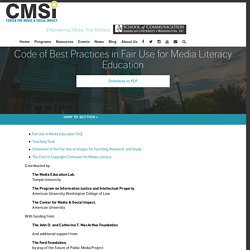
Code of Best Practices in Fair Use for Online Video - Center for Media and Social Impact. Introduction What This Is This document is a code of best practices that helps creators, online providers, copyright holders, and others interested in the making of online video interpret the copyright doctrine of fair use.

Fair use is the right to use copyrighted material without permission or payment under some circumstances. This is a guide to current acceptable practices, drawing on the actual activities of creators, as discussed among other places in the study Recut, Reframe, Recycle: Quoting Copyrighted Material in User-Generated Video and backed by the judgment of a national panel of experts. It also draws, by way of analogy, upon the professional judgment and experience of documentary filmmakers, whose own code of best practices has been recognized throughout the film and television businesses.
Newswise. Newswise — A national magazine tells a professor she needs hundreds of permissions to use its cover photos in her class, when in fact, she could claim fair use, which does not require payment or permission.
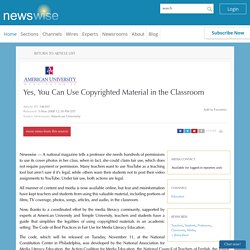
Many teachers want to use YouTube as a teaching tool but aren't sure if it's legal, while others warn their students not to post their video assignments to YouTube. Under fair use, both actions are legal. All manner of content and media is now available online, but fear and misinformation have kept teachers and students from using this valuable material, including portions of films, TV coverage, photos, songs, articles, and audio, in the classroom. Things That Can Happen When You Get Caught Breaking Copyright Laws.
Copyright laws exist to protect individuals' and organizations' proprietary creations, granting creators of proprietary property the sole right to produce, distribute and profit from their own creation for a set number of years.

In order to maintain these protections, copyright laws are paired with criminal and civil penalties for those caught reproducing or stealing copyrighted goods. The consequences of breaking copyright laws extend beyond the courtroom, as well, as publicized copyright-infringement cases can damage a company's reputation for years. Civil Lawsuits The first line of defense for copyright holders is civil litigation, in which the owner of a copyright sues a transgressor in civil court. According to the U.S. Criminal Charges. MIT Libraries launches online Fair Use Quiz for students. Untitled. Copyright 101: A Simple Lesson in Licenses. Center for Media & Social Impact. Dramatic Chipmunk Tackles Fair Use Rights. The Code of Best Practices in Fair Use for Media Literacy Education.
Copyright Clearance Center. Copyright Basics.
Citing-images-onblog-tolisano.png (PNG Image, 1588 × 2247 pixels) - Scaled (44%) Free photos. Citing Images overview. How Not to Steal People's Content on the Web. The best content marketers aren't afraid to share.
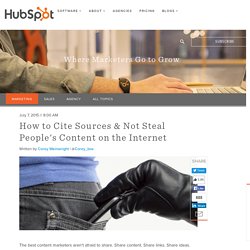
Share content. Share links. Share ideas. Share data. The thing is, sometimes marketers get a little protective of their stuff because there are less-than-scrupulous people out there who take content and then try to pass it off as their own. But sometimes it isn't a matter of people being jerks -- they might just not know how the internet "works. "
Free Pictures of Everything on Earth. eSchool News Finding copyright-friendly photos for the Google Images generation. Searching and citing usable images is easy once students learn the basics Teaching students to respect the intellectual property of others is important in this digital “cut and paste” world we live in.
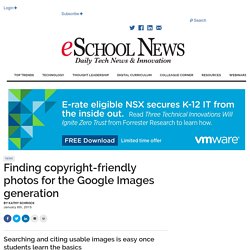
One great project to share with students that can better help them understand how and when they may use images created by others is the Creative Commons project. Creative Commons is designed to span the gap between full copyright and the public domain. The Creative Commons project provides content creators the opportunity to state ahead of time how their images may (or may not) be used. When an image creator posts an image online and applies a Creative Commons license to it, there are four conditions/restrictions they can apply to the image:
The Code of Best Practices in Fair Use for Media Literacy Education. Click here to view or download a PDF of this report.

Coordinated by: The Media Education Lab,Temple UniversityThe Program on Information Justice and Intellectual Property,American University Washington College of LawThe Center for Media & Social Impact,American University With funding from: The John D. and Catherine T. MacArthur Foundation. If not for Congress, Superman, Lassie and Scrabble would be free for anyone to reproduce tomorrow. On Jan. 1, a whole raft of artistic and intellectual works will be making their way into the public domain — or they would be if Congress hadn't extended copyright terms for the umpteenth time in 1998.

At its core, copyright is meant to protect authors and creators. But as we've seen recently with a battle over Sherlock Holmes, copyrights can sometimes prevent well-meaning fans from showing the depth of their appreciation for a work by becoming creators themselves. These days things that were published before 1978 enjoy copyright protections of up to 95 years, but that wasn't always the case.
Under the rules Congress made before the most recent term extension, rights-holders of older works were protected for just 75 years — at which point the work would enter the public domain and be free for anyone to use or riff upon. Welcome To The FACE Kids Site. U.S. Copyright Office. Study: Piracy actually helps small films make money. "Harry Potter" and other big-budget blockbusters benefited from the shutdown of Megaupload more than small- and medium-size films.
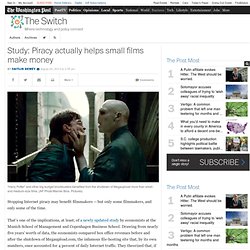
(AP Photo/Warner Bros. Pictures) Stopping Internet piracy may benefit filmmakers -- but only some filmmakers, and only some of the time. That’s one of the implications, at least, of a newly updated study by economists at the Munich School of Management and Copenhagen Business School.